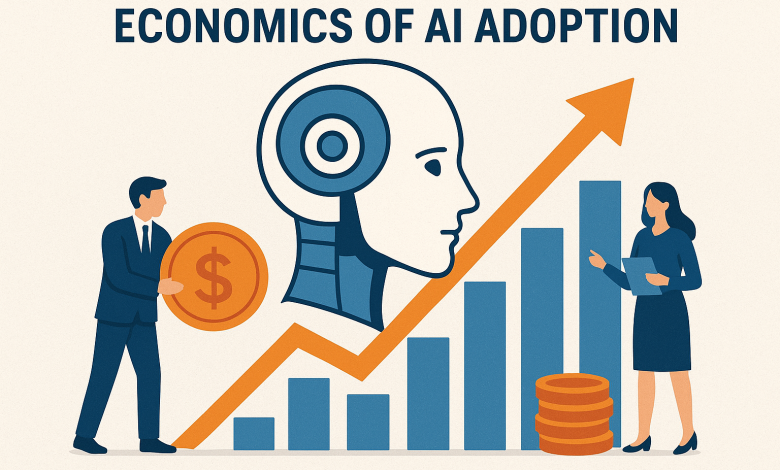
The conversation around artificial intelligence has shifted dramatically over the past two years. What began as speculative discussions about potential applications has evolved into a practical race for measurable business outcomes. Companies are no longer asking whether they should adopt AI, but rather how to extract genuine return on investment from their implementations. The gap between AI experimentation and AI profitability comes down to discipline, not technology.
As someone who has built multiple technology platforms serving hundreds of thousands of users globally, I’ve observed a clear pattern. The organizations achieving real ROI from AI are those that approach adoption with the same rigor they apply to any capital investment: clear metrics, defined objectives, and systematic measurement frameworks. Success requires moving beyond pilot programs to integrated systems that deliver consistent, measurable value.
Moving Beyond the Pilot Phase
Most businesses have completed their initial AI experiments. They’ve tested chatbots, explored content generation tools, and experimented with predictive analytics. The question now is how to scale these implementations in ways that deliver consistent, measurable value.
The challenge lies in transitioning from isolated use cases to integrated systems that compound value over time. A marketing team might see impressive results from AI generated social media content, but the real opportunity emerges when that same system connects to customer data platforms, sales pipelines, and product development feedback loops. Integration multiplies impact in ways that standalone tools cannot achieve.
Building a Framework for AI ROI Measurement
Effective AI ROI measurement requires moving beyond vanity metrics to economic fundamentals. Organizations must establish systematic approaches that quantify both cost savings and revenue impact. Here’s a practical framework that businesses can implement immediately to track real returns.
Define Baseline Performance
Before deploying any AI system, establish clear metrics for current performance. This includes time spent on tasks, error rates, conversion percentages, customer satisfaction scores, and labor costs. Without accurate baselines, ROI calculations become speculative exercises rather than business intelligence. Measuring improvement requires knowing where you started.
Identify Direct Cost Savings
Calculate the explicit costs that AI systems eliminate or reduce. This includes labor hours reallocated to higher value activities, reduction in software licensing fees for replaced tools, decreased error correction costs, and reduced customer acquisition expenses. These are your immediate, tangible returns that appear directly on financial statements.
Measure Productivity Multipliers
Beyond direct savings, quantify how AI enables existing team members to accomplish more. If a content strategist can now oversee eight campaigns instead of three due to AI assisted creation and optimization, that represents a productivity multiple of 2.67x. These multipliers often exceed direct cost savings in total value creation. They represent capacity expansion without proportional cost increases.
Track Revenue Impact
The most significant ROI often comes from revenue increases rather than cost reductions. Monitor conversion rate improvements, customer lifetime value changes, reduced churn rates, and accelerated sales cycles. AI systems that optimize customer interactions or personalize offerings typically show measurable revenue impact within 60 to 90 days. Revenue growth compounds over time as systems learn and optimize continuously.
Real World Applications Across Business Functions
Customer Support and Service Optimization
Customer service represents one of the highest ROI opportunities for AI implementation. Modern AI systems can handle routine inquiries, triage complex issues, and provide instant responses 24/7. The economics are compelling across multiple dimensions.
Organizations implementing AI powered support systems typically see response time reductions of 70 to 85 percent. Support ticket volume for human agents decreases by 40 to 60 percent. Customer satisfaction scores improve by 15 to 30 percent. More importantly, these improvements compound as faster resolutions lead to higher satisfaction, which drives retention and increases lifetime value.
The key is proper implementation focused on real world scenarios. Systems must be trained on actual customer interactions, not generic datasets. They need clear escalation protocols for complex scenarios. Human agents should focus on high value interactions that build relationships and solve nuanced problems.
Content Marketing and SEO Strategy
Content creation and optimization have been transformed by AI capabilities. However, the ROI equation differs significantly from customer support applications. The value here comes from scale and speed, not replacement. Organizations must understand this distinction to measure returns accurately.
Marketing teams leveraging AI for content workflows report production capacity increases of 200 to 400 percent while maintaining quality standards. This doesn’t mean replacing writers with algorithms. It means enabling strategists to produce first drafts faster, optimize existing content more efficiently, and test variations at scale. Research from the Content Marketing Institute indicates that organizations using AI assisted content strategies see organic traffic growth rates 2.3x higher than those relying solely on manual processes.
The ROI calculation must account for the full funnel impact. Increased content production means more keyword coverage, which drives traffic growth, which generates more leads, which converts to revenue. Each stage amplifies the previous one, creating compound returns that exceed simple productivity gains.
Operational Analytics and Decision Intelligence
Perhaps the most underutilized AI application is operational analytics. Most businesses generate enormous amounts of data but lack the analytical capacity to extract actionable insights consistently. AI systems excel at pattern recognition across large datasets, identifying opportunities and risks that human analysts might miss. The ROI potential here is substantial but often overlooked.
Companies implementing AI driven analytics platforms report decision cycle reductions of 40 to 60 percent. Forecast accuracy improves by 25 to 45 percent. Systems identify revenue opportunities worth 5 to 15 percent of annual revenue. These aren’t theoretical benefits but real money identified through systematic analysis.
The implementation key is connecting data sources effectively. An AI system analyzing sales data in isolation provides limited value. Connect that same system to marketing performance, customer service interactions, product usage patterns, and market trends, and it becomes a strategic intelligence engine. According to McKinsey’s research on AI adoption, organizations that successfully integrate cross functional data sources see ROI figures 3.5x higher than those using siloed implementations.
Responsible Scaling and Risk Management
Achieving sustained ROI from AI requires addressing risk factors that can erode returns over time. Three areas demand particular attention from leadership teams. Ignoring these factors can transform profitable implementations into costly failures.
Data Quality and Integrity
AI systems are only as reliable as their training data. Organizations must implement systematic data validation processes, regular bias audits, and continuous quality monitoring. Poor data quality doesn’t just reduce effectiveness; it can lead to costly errors that offset gains. Investment in data infrastructure pays dividends across all AI implementations.
Change Management and Adoption
Technology implementation fails when people resist adoption. Successful AI scaling requires transparent communication about how systems work, clear training on new workflows, and demonstrated value to end users. Teams that understand how AI enhances their capabilities embrace it. Teams that feel threatened by it find ways to work around it, destroying potential returns.
Ethical Guidelines and Governance
As AI systems take on more decision making authority, organizations need clear ethical frameworks. This includes transparency about AI use, human oversight for consequential decisions, and regular audits for unintended bias or discrimination. The reputational and legal risks of poorly governed AI can exceed implementation costs many times over. Governance isn’t overhead; it’s risk mitigation with measurable financial impact.
Cross Team Upskilling for Sustained Value
The organizations extracting maximum ROI from AI investments treat implementation as an organizational capability, not a technology deployment. This requires systematic upskilling across multiple functions. Technology alone never delivers value; trained people using technology effectively deliver value.
Technical teams need training not just in prompt engineering and system configuration, but in understanding business objectives and translating them into technical requirements. Business teams need sufficient technical literacy to evaluate AI capabilities realistically and identify high value use cases. Leadership teams need frameworks for assessing AI investments using the same rigor they apply to other capital allocation decisions. This multi level capability building ensures AI implementations align with actual business needs.
The ROI of upskilling often exceeds the ROI of the AI systems themselves. A well trained team can identify opportunities, implement solutions faster, troubleshoot issues independently, and optimize continuously. Organizations that invest in capability building see 60 to 80 percent faster time to value on new AI implementations compared to those that rely solely on external vendors or consultants. Skills compound over time as teams gain experience and confidence.
Looking Forward: AI Evolution and Market Transformation
The AI landscape is evolving rapidly, with clear implications for how organizations should approach adoption and ROI planning. Several trends are reshaping the economic equation. Understanding these shifts helps businesses make smarter investment decisions today that position them for future success.
Commoditization of Basic AI Capabilities
Tools that required custom development 18 months ago are now available as plug and play solutions. This democratization means ROI calculations must account for decreasing implementation costs but also increased competitive pressure. Early adopters gained competitive advantage; today’s adopters are maintaining competitive parity. The strategic question shifts from “should we adopt” to “how do we differentiate our implementation.”
Rise of Agentic Systems
The next wave involves AI agents that don’t just analyze or generate, but execute decisions autonomously within defined parameters. These systems promise ROI improvements of 10x or more in specific applications, but they also introduce new risk categories that must be managed carefully. Organizations should begin evaluating agentic capabilities now while establishing governance frameworks that enable safe deployment. The competitive advantage will go to those who move quickly but carefully.
Integration Ecosystems
The future belongs to platforms that connect multiple AI capabilities into coherent workflows. Organizations should evaluate AI investments not just on standalone merit, but on integration potential. Systems that play well with others deliver compounding returns; isolated tools create data silos and workflow friction. According to Gartner research, integrated AI platforms deliver 4.2x higher ROI than point solutions over three year periods.
The freelancing, SaaS, and digital service marketplace sectors will see particularly dramatic transformation. AI is enabling solo practitioners to deliver services previously requiring teams, allowing small agencies to compete with enterprise providers, and creating entirely new service categories that blend human expertise with AI execution. Platforms that facilitate these hybrid models will capture disproportionate value over the next 24 to 36 months.
From Experimentation to Strategic Implementation
The opportunity for AI driven business value has never been greater, but capturing that value requires moving beyond experimentation to strategic, measured implementation. Organizations that succeed will be those that treat AI as an investment category requiring clear ROI metrics, disciplined deployment, continuous optimization, and systematic risk management. Success follows from process, not from technology selection alone.
The economics are increasingly clear across industries and company sizes. Companies implementing AI with proper frameworks and governance see average ROI of 200 to 400 percent within 18 months of deployment, with returns accelerating as systems learn and integrate more deeply into operations. These aren’t speculative projections; they’re outcomes from organizations that approached AI adoption with the same rigor they apply to any major business investment. The data proves that disciplined implementation delivers measurable returns.
The question isn’t whether AI will transform business economics. It’s whether your organization will capture that value through disciplined implementation or watch competitors pull ahead while you remain in perpetual pilot mode. The tools are available, the frameworks are proven, and the window for competitive advantage is narrowing. The time for experimentation has passed and the era of measurable, systematic AI value creation has arrived.




